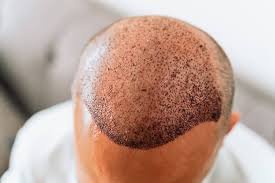If you’ve just had a hair transplant, you’re probably excited to see your new hair growing in. But you might also be wondering what you can do to make the results even better. One common question people ask is, “Can I use minoxidil after a hair transplant?” You’ve probably heard about it already. It’s used to treat hair loss and thinning. But is it safe to use after surgery? And what about the Minoxidil Side Effects?
Let’s break everything down in the simplest way possible. By the end of this article, you’ll know exactly what to do, how to use minoxidil, when to start, and what to expect.
Table of Contents
What Is Minoxidil and Why Is It Popular?
Minoxidil is a medicine that helps with hair growth. It comes as a liquid or foam that you apply directly to your scalp. It improves blood flow to the hair roots and makes the hair grow thicker and stronger. You might know it by the brand name Rogaine. It has been around for a long time and is one of the most trusted solutions for hair loss.
Many people use minoxidil even before getting a hair transplant in India. But after surgery, it can still be useful. It doesn’t grow new hair where none exists, but it helps protect and improve the existing hair.
Is It Safe to Use Minoxidil After Hair Transplant?
The short answer is yes, but not immediately. Your scalp needs some time to heal after the transplant. Most doctors suggest waiting for about two to four weeks. This gives the newly transplanted grafts time to settle in. Once your scalp is healed, using minoxidil can help improve the results and support overall hair growth.
If you’re unsure, always ask your doctor before starting anything new on your scalp. They’ll check if it’s the right time to start minoxidil or if you should wait a bit longer.
Why Do Doctors Recommend Minoxidil After Surgery?
There are a few good reasons why your doctor may suggest minoxidil after a hair transplant in India. First, it helps with something called “shock loss.” That’s when some hair near the transplant area falls out due to stress from surgery. It’s totally normal and usually temporary.
Minoxidil can help reduce this shock loss. It also speeds up the growth cycle of the hair. So the new hair that’s been transplanted may grow a bit quicker and thicker with minoxidil. Even your natural hair will benefit from the daily application.
What Are the Common Minoxidil Side Effects?
Let’s talk about Minoxidil Side Effects. Most people don’t face any major problems while using it. But like any product, there are some mild side effects that may happen. The most common ones include scalp dryness, itching, redness, or a slight burning feeling after applying.
Sometimes, people notice a bit more hair fall at first. That might sound scary, but it’s actually a good sign. The weak hair is falling out to make way for new, stronger hair. This stage usually passes in a few weeks.
Rare side effects include chest pain, dizziness, or swelling in your hands or feet. These are not common, but if they happen, you should stop using minoxidil and see a doctor immediately.
How and When to Start Using Minoxidil
Once your doctor gives you the green light, you can start using minoxidil every day. It’s usually applied once or twice a day, depending on the brand or your doctor’s advice. Make sure your scalp is dry and clean. Use the dropper or foam to apply it directly to the area. Gently spread it, but don’t rub it too hard.
It’s best to leave it on for at least four hours before washing your head. Wash your hands after each use. If you skip it now and then, it’s not a big deal, but regular use gives better results.
If your hair transplant in India was done by an experienced clinic, they’ll give you proper aftercare tips, including how and when to use minoxidil.
Does Minoxidil Make the Transplant Results Better?
Minoxidil doesn’t grow new hair in the transplanted spots. That job is already done during the surgery. But it plays a strong supporting role. It keeps the nearby hair strong and healthy. It also helps the newly transplanted follicles stay in good condition and may encourage faster growth.
So while it doesn’t increase the number of hairs, it improves the look, volume, and thickness of your hair overall. That’s why many doctors include it as part of a full hair care routine after a transplant.
Who Should Avoid Using Minoxidil?
Even though minoxidil is safe for most people, it’s not for everyone. If you have a history of heart issues, very sensitive skin, or allergies to certain skin products, talk to your doctor before using it.
Pregnant or breastfeeding women should avoid using minoxidil unless specifically told by a doctor. Always do a patch test before applying it to a large area. Try it on a small spot first and wait a day to check for any reaction.
How Long Should You Continue Using Minoxidil?
This depends on your hair goals. Some people use minoxidil for six months after their transplant and then stop. Others continue for years because it helps with the overall look of their hair.
If you stop using it, your transplanted hair will still stay, because that hair is permanent. But the natural hair around it might start to thin again over time. That’s why some people keep using it as part of their daily hair care. It’s a personal choice, and you can adjust based on what works for you.
Final Thoughts
So, can you use minoxidil after a hair transplant? Yes, you can. And in most cases, you should. It’s safe, simple to use, and helps protect your results. Just make sure you wait for the right time to start. Two to four weeks is usually fine, but always ask your doctor to be sure.
Be aware of Minoxidil Side Effects, and keep an eye on how your scalp reacts. If you feel fine, keep using it regularly. It supports the new hair, protects your natural strands, and gives your whole head a fuller look. If your hair transplant went well, you’ve already done the hard part. Now it’s all about good care, patience, and a little help from products like minoxidil. Over time, your hair will thank you.



